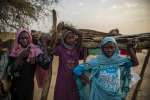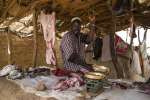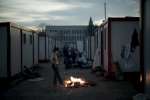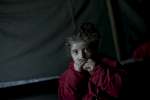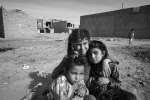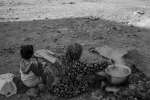- Text size
 |
|  |
|  |
| 
- Français
Spanish artists help fight malnutrition among African refugees
News Stories, 26 January 2009

MADRID, Spain, January 26 (UNHCR) – A close partner of the UN refugee agency has persuaded some of Spain's top artists to support an exhibition and online auction to raise money to tackle malnutrition among young refugees in four African countries.
The Spanish Committee for UNHCR, with the emceeing skills of UNHCR Goodwill Ambassador Jesús Vázquez, launched "Refugi@rte" in Madrid last Tuesday. Almost 50 works of art went on display at the BBVA exhibition hall, including pieces by artists such as Miquel Barceló, Eduardo Chillida, Joan Genovés, Cristina Iglesias, Antonio Saura, Antoni Tàpies and Manolo Valdés.
The art was donated by the artists and various art galleries – art lovers can bid for them online until Friday morning. There are a wide range of different styles, including paintings, etchings, lithographs and ceramics.
Some of the images have refugee themes. "A Kite for UNHCR," an acrylic painting on canvas by Genovés, has black brushstrokes symbolizing people fleeing. A hand in the foreground reaches out to help someone. A work donated by the great Brazilian photographer Sebastião Salgado portrays the tremendous dignity conveyed by an Ethiopian refugee woman.
"I would really like to see 'Refugi@rte' become a yearly meeting point between refugees and art," said Vázquez, one of Spain's most popular TV presenters. He noted that those buying the art would be helping to save the lives of people forced to flee their homes.
The funds raised from the online auction will be used to fund UNHCR projects to prevent malnutrition among young refugees in Chad, Ethiopia, Kenya and Sudan. More than 4 million children die each year from malnutrition around the world.
"We artists live in our own world, and our sensitivity is as short-lived as a television news programme," artist Víctor Ochoa said at the exhibition opening. "Organizations like UNHCR help us keep the humanitarian spirit alive and allow our work to transcend the purely artistic level."
By María Jesús Vega in Madrid, Spain











